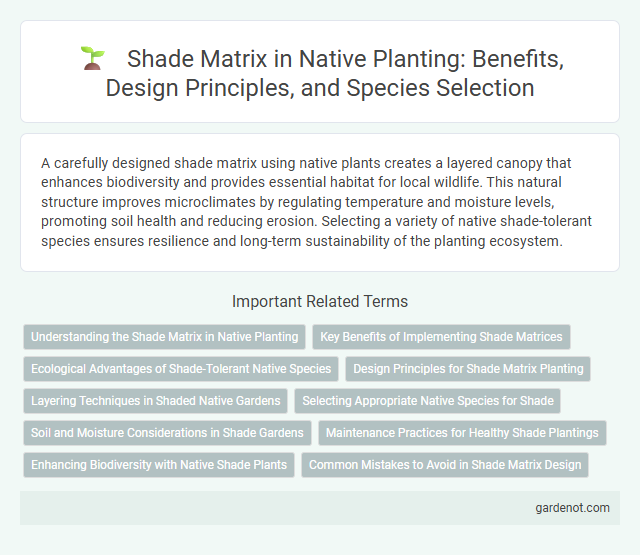A carefully designed shade matrix using native plants creates a layered canopy that enhances biodiversity and provides essential habitat for local wildlife. This natural structure improves microclimates by regulating temperature and moisture levels, promoting soil health and reducing erosion. Selecting a variety of native shade-tolerant species ensures resilience and long-term sustainability of the planting ecosystem.
Understanding the Shade Matrix in Native Planting
The shade matrix in native planting refers to the varying levels of sunlight filtered through tree canopies, influencing undergrowth species composition and growth patterns. Understanding this matrix is essential for selecting native plants adapted to light conditions ranging from full sun to deep shade, ensuring ecological balance and plant health. Accurate assessment of light availability promotes biodiversity and supports habitat restoration efforts by aligning species needs with specific shade niches.
Key Benefits of Implementing Shade Matrices
Shade matrices enhance plant growth by simulating natural canopy conditions, improving light distribution and reducing stress on native species. These structures increase biodiversity by creating microhabitats that support various flora and fauna, promoting ecological balance. Implementing shade matrices also conserves soil moisture and reduces temperature fluctuations, fostering healthier root development and improving overall plant resilience.
Ecological Advantages of Shade-Tolerant Native Species
Shade-tolerant native species contribute significantly to ecological stability by enhancing biodiversity and providing essential habitats for wildlife in low-light environments. Their deep root systems improve soil structure and water retention, reducing erosion and supporting nutrient cycling within shaded ecosystems. Integrating a diverse shade matrix of native plants fosters resilient forest understories that adapt to climate variability and sustain interconnected ecological networks.
Design Principles for Shade Matrix Planting
Design principles for shade matrix planting emphasize selecting native species that thrive under low light conditions, ensuring ecological compatibility and biodiversity. Layering plant structures with varying heights and foliage densities creates effective canopy coverage, promoting microhabitats and soil health. Incorporating seasonal variation enhances year-round shade benefits while supporting pollinators and native wildlife.
Layering Techniques in Shaded Native Gardens
Shade matrix in shaded native gardens utilizes layering techniques that combine canopy trees, understory shrubs, and groundcover plants to maximize biodiversity and spatial efficiency. Native species such as dogwood, spicebush, and ferns thrive within these vertical layers, creating microhabitats that support pollinators and wildlife. This stratified planting approach improves soil health, reduces erosion, and enhances natural shade tolerance.
Selecting Appropriate Native Species for Shade
Selecting appropriate native species for shade involves understanding the specific light requirements and growth habits of plants adapted to low-light environments. Species such as ferns, trilliums, and wild ginger thrive under dense tree canopies, providing vital ground cover and supporting local biodiversity. Implementing shade-tolerant native plants enhances ecosystem resilience while minimizing water usage and maintenance needs in shaded landscapes.
Soil and Moisture Considerations in Shade Gardens
Shade gardens require well-draining soil rich in organic matter to support native plants adapted to low-light conditions. Moisture retention is critical, as shaded areas often experience slower evaporation but can suffer from both dryness and waterlogging depending on soil type and local climate. Selecting native species with specific soil moisture preferences ensures a healthy, resilient shade matrix that thrives under variable light and moisture conditions.
Maintenance Practices for Healthy Shade Plantings
Effective maintenance practices for healthy shade plantings include regular pruning to remove dead or diseased branches, which promotes air circulation and reduces pest infestations. Mulching around native shade plants conserves soil moisture, suppresses weeds, and improves soil fertility by gradually decomposing. Implementing proper watering schedules tailored to native species' needs ensures deep root growth and resilience against drought conditions.
Enhancing Biodiversity with Native Shade Plants
Shade matrix designs incorporating native plants significantly enhance biodiversity by creating multi-layered habitats that support diverse wildlife species. Utilizing native shade trees such as oaks, maples, and hickories fosters symbiotic relationships with local pollinators, birds, and soil microorganisms, promoting ecosystem resilience. These native shade plants improve soil health and water retention, reducing erosion while providing essential food and shelter resources for native fauna.
Common Mistakes to Avoid in Shade Matrix Design
Avoid overcrowding shade matrix designs by selecting species with varying canopy densities to ensure optimal light penetration and healthy undergrowth. Incorporate native plants with different growth habits to prevent competition for resources and maintain biodiversity. Neglecting soil type and moisture preferences often leads to poor plant establishment and long-term maintenance challenges.
Shade matrix Infographic

 gardenot.com
gardenot.com